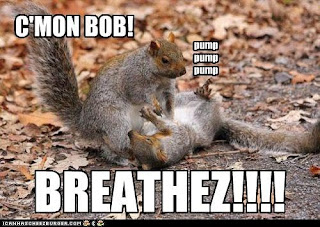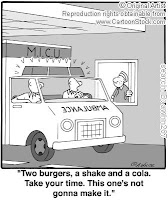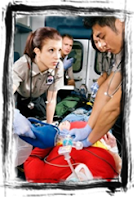
The Angel of Grief, Photo courtesy of *AfEX from flickr
Death (Bengt Ekerot) from the film, The Seventh Seal, about...death's announcement
As I stated in part 1, this is an area where EMS education and training are lacking, thus a reason why EMS providers don't like being the bearer of bad news of death and would rather refer this to the "professionals". But we are the professionals. This really should be our job.
Training in grief support is not taught well, if at all, in initial EMS certification programs, but when EMS providers attend grief support training programs, they are more inclined to be willing to confront the family and provide grief support (Smith and Feldman, 2004) only if they have the training. There are training programs like Death Notification Training by MADD (which I took), Griefstep and Coping with the Death of a Child, by the AHA, are available as continuing education. Others have great online slide presentations for death notification, such as GRIEV_ING Death Notification Protocol for interns by Dr. Hobgood, Expected Death: What does a paramedic do? byt SunnybrookOsler centre for prehospital care, and Death Notification for Paramedics by Greg Soto, just to name a couple. However core training in death education for EMS is substandard and not consistent. The minimum required training in this area is lacking. Here is another reason I advocate for a college degree being the minimum standards for EMTs and Paramedics, with a death education course being a requirement, such as Psychology of Death and Dying. There is much on the web designed for police officers, the traditional bearer of bad news, such as Bad News Bearers, by Moldovan (2009), Death Messenger, The Road Less Traveled and Death and Grieving from the PCLEC training manual.
Family response to field terminations
Many family members feel the deceased would rather have died at home than in a less than personal atmosphere of the hospital (Edwardson, Chiumento, and Davis, 2002). In fact, the family of transported patients felt less positive interactions with the EMS and ED staff and felt anxiety when rushing into an ED (Delbridge, Fosnocht, Garrison and Auble, 1993). However those who were surveyed after field termination by providers with grief support training (Schmidt and Harrahill, 1995) expressed very positive experiences.

In 2000, the American Heart Association ECC guidelines advocated keeping family present during the resuscitation (AHA, 2000). It is hard for EMS to exclude them when resuscitation is being attempted in the home of the patient with family present (Boyd, 2000). Often, it is tempting to ask family to leave the room or ask police to escort them out. Many EMS providers don’t like having family present s they can be disruptive, interfere with procedures and possibly faint. Others are worried about potential liability as family members may not like what they see, whether they understand it or not, and sue. However, many family members wish to present and most, though loud, do not interfere and feel being at their loved one’s side is comforting and gives them an opportunity to say goodbye (Offord, 1998). Many also said it helped them with their bereavement process in coping with the loss of their loved one. Some family members may wish to leave the room while others may interfere but most feel closer to what is happening, and feel lonely in another room waiting for information (Soto, 2009). If family interfere with resuscitation efforts, then ask them to leave. Otherwise, ask family if they wish to be present. Some will, and some won’t, but they appreciate being asked. Professionalism and sensitivity need to be exhibited by the crew. Having the family present offers them a chance to help or be involved, lessening stress. Not only that, the family actually can help, by answering questions and clarifying the history of the present illness to even helping with CPR if they feel confident about it (Shaner and Eckle, 1997).
However, many family members wish to present and most, though loud, do not interfere and feel being at their loved one’s side is comforting and gives them an opportunity to say goodbye (Offord, 1998). Many also said it helped them with their bereavement process in coping with the loss of their loved one. Some family members may wish to leave the room while others may interfere but most feel closer to what is happening, and feel lonely in another room waiting for information (Soto, 2009). If family interfere with resuscitation efforts, then ask them to leave. Otherwise, ask family if they wish to be present. Some will, and some won’t, but they appreciate being asked. Professionalism and sensitivity need to be exhibited by the crew. Having the family present offers them a chance to help or be involved, lessening stress. Not only that, the family actually can help, by answering questions and clarifying the history of the present illness to even helping with CPR if they feel confident about it (Shaner and Eckle, 1997).
The final blow
Continue efforts while you send someone to speak to the family, and get their consent to cease efforts. Then notify medical command and get authorization to TOR. Ensure the friendliest member of the crew who has been updating the family, or the crew leader, possibly with another member, should make the notification. If you are that person, take off your gloves, tuck in your shirt and wipe sweat from your face. Join the family and make an introduction, but direct yourself to the spouse, parent or paramour. Shake hands and ideally, ask to sit down with the family and have an attentive posture at eye level, trying not to stare, leaning forward with hands on knees (Hobgood, 2005). State despite all possible efforts, the patient has died. Steer clear of trying to use euphemisms or softer terms for death. The family will usually want it straight and quick. It may also be helpful to give an overview again of the procedures that were done to save their loved one (Meoli M, 1993). It is important to not show distance from the patient as we normally do, but use the patient's name when addressing the family. Grief support It is important to be empathetic with the family. They will experience a variety of emotions such as: They should be encouraged to show their emotions. A variety of emotions can be expected, from silence to loud weeping and the providers should not be judgmental. The EMS provider should give the family time to reflect or react. Let them express themselves, letting them know they are heard by using one or two of their key words or paraphrase what they ask or say. You will not have to speak too much. Just sitting and listening is enough. Photo courtesy of www.mentalhelp.net Express sympathy and concern, and use phrases that express your feelings and acknowledgement of their loss, such as:
- "I am sorry for your loss"
- "I see that it is difficult to accept the loss of..."
- "I can't imagine how difficult this is for you"
- "I know this is very painful for you"
- "It must be hard to accept"
- "It's harder than most people think"
- "You must have been very close to him/her"
- "It is normal for you to react as you are"
- "How can I help"

A provider should not be expected to know what magical things to say, but could just say “I am sorry. I don’t know what to say”. Be aware of your responses as they can reflect withdrawn or distant, antagonism or defensive to family reactions, indifference or being unflappable, too clinical, fear or even being curt. Ensure you express empathy, understanding, sorrow and concern but don't feel you have to keep talking-just being there is usually sufficient.
Photo courtesy of http://www.saveourparamedics.com/Be careful to avoid these phrases:
His/her death was for the best
- I know how you feel. My ? died last year
- We all have to deal with loss
- At least he/she died in their sleep
- Religious cliches, such as he/she is in a better place
- You should not feel that way
- Aren't you lucky that at least...
- Snap out of it! Get a hold of your self!
You must focus on your precious moments
- You at least have another child or ...
Touching is alright, but let the family members express the cue for that. If they want to hug you, let them but don't initiate it.

Photo courtesy of articles.mercola.com
Assist with logistics
Offer drinks such as making them tea or coffee or just getting them water (Meoli, 1993). Ask if there is additional family or friends, and especially clergy who they may want called. The family needs to know what the formal death notification procedures are in relation to the coroner and PCP and even the police, if necessary. They will need to be told EMS will need past medical history and medications and will contact the patient’s PCP to see if the PCP will sign a death certificate. The coroner will also need notified and the family should be told of an impending autopsy if warranted, or ask them if they want one done. The funeral home will need to be called if the deceased is not getting an autopsy, and the crew should offer to do this for the family. Try to be open with cultural diversity in regard to assisting with family and even positioning of the body.
Care of the body
While a crew member is conferring with the family, the body needs prepared and the family will need to be told of what to expect as far as ET tube and IVs. If the body will go with the funeral home, the tubes and catheters should be pulled and the mess of resuscitation cleaned up, and the body placed in bed if possible. A sheet should be put over the patient, but the family should be asked if they want the head exposed, as most do. The family should not be discouraged from touching or talking to the deceased, but rather encouraged unless it is a crime scene (Leash, 1996). 
Autopsy case
If it is an autopsy case, especially of a child, the family may or may not be cooperative. This takes a lot of empathy and great skill in explaining the legal issues and why an autopsy needs done. They need to be told an ambulance crew or police officer needs to be present until the coroner arrives, and why scene preservation is important, if required.

Photo courtesy of The Pittsburgh Post Gazette
Departure
Most EMS crews do not want to stay longer than they should and the family need time to themselves, but must ensure they family has no other questions or requests before leaving. They should approach the family and state they will be leaving and ask if there is anything else that can be done. Have brochures or business cards for the local victim/crisis services and offer one to the family if they wish grief counsling. Usually a single family member may not want left alone until more family or friends arrive. Providers should ensure to offer condolences to all family and friends present, showing sincerity, and then say good bye.
No discussion of grief can go without listing The 5 Stages of Death by Dr. Kubler-RossYour own personal mental fitness

Summary
EMS providers find dealing with death a stressful situation but routine exposure desensitizes them. However, EMS providers are often uncomfortable with interacting with grieving family and friends and death notification as it is physically and emotionally exhausting. The crew must expect to “express the right words, anticipate and understand family emotions, and respond with empathy.” They don’t want to leave a wrong impression of being callous, thoughtless and insensitive(Page, 2008). Added death notification training or death education is necessary for EMS providers and will help alleviate any discomfort they may have in this important role. I suggest if you have not attended similar training, take advantage of it when it is offered in your region. Contact MADD about doing a training program. And remember to always keep in mind your own mental well being as these are stressful roles.
 Photo by Shawn Raecke, at Health.idahostatesman.com
Photo by Shawn Raecke, at Health.idahostatesman.comReferrences:
American Heart Association (AHA), (2000), 2000 American Heart Association Guidelines for Cardiopulmonary Resuscitation and Emergency Cardiovascular Care, Part 2: Ethical Aspects of CPR and ECC, Circulation.
American Heart Association (AHA), (2005), 2005 American Heart Association Guidelines for Cardiopulmonary Resuscitation and Emergency Cardiovascular Care, Part 2: Ethical Issues, Circulation. 2005;112:IV-6 – IV-11
Bereavement. In: Resuscitation Council UK Advanced Life Support Course Manual; 1998
Boyd R., (2000) Witnessed resuscitation by relatives, Resuscitation. 2000 Feb;43(3):171-6.
Delbridge T, Fosnocht D, Garrison H, Auble T., (1996), Field Termination of Unsuccessful Out-of-Hospital Cardiac Arrest Resuscitation: Acceptance by Family Members, Annals of Emergency Medicine Volume 27, Issue 5, May 1996, Pages 649-654
Edwardsen EA, Chiumento S, Davis E., (2002), Family perspective of medical care and grief support after field termination by emergency medical services personnel: a preliminary report, Prehospital Emergency Care. 2002 Oct-Dec;6(4):440-4.
Grief Support Institute, (1998) Say the Right Thing: EMS Death Notification and Grief Support Guidelines
Hobgood, Cherri, (2005), "Delivering the News With Compassion: The GRIEV_ING Death Notification Protocol", Trainers Manual.
Iserson KV. (2000) Notifying survivors about sudden, unexpected deaths. Western Journal of Medicine 2000; 173: 261–265.
Leash RM., (1996) Death notification: practical guidelines for health care professionals, Critical Care Nursing Quarterly. 1996 May;19 (1):21-34.
Meoli M., Supporting the bereaved. Field notification of death, JEMS. 1993 Dec;18(12):39-46.
Moldovan, Emil, (2009), "The Bad News Bearers: The Most Difficult Assignment in Law Enforcement", http://www.csa.com/
Offord RJ.. (1998) Should relatives of patients with cardiac arrest be invited to be present during cardiopulmonary resuscitation? Intensive Critical Care Nursing. 1998; 14: 288–293
Overweg, Cynthia, (2007), "Saving Lives Sometimes Trigger Crises", Ventura County Star
Placer County Law Enforcement Chaplaincy, "Death and Grieving", Training Manual, Chapter 6
Page, Douglas, (2008), Death notification: Breaking the bad news: Why does so little training exist for the most grim job in law enforcement?, Officer.com, March
Schmidt TA, Harrahill MA., (1995), Family response to out-of-hospital death, Academy of Emergency Medicine. 1995 Jun; 2(6):513-8.
Smith L, Feldman, R (2004), THE EFFECT OF TWO DEATH EDUCATION PROGRAMS ON EMERGENCY MEDICAL TECHNICIANS, Prehospital Emergency Care, January / March 2006 Volume 10 / Number 1
Smith L, Feldman R, (2005), Survey of EMTs’ Attitudes towards Death, Prehsospital and Disaster Medicine, May-June
Smith, Mike, (2008) Recognizing and Managing Futility: Take a proactive approach with tragic events, EMS Magazine, May 2008 Issue
Smith, T., (2009), Emergency Medical Technicians, Encyclopedia of Death and Dying.
Soto, Greg, Cooke, David, Death Notification for Paramedics, TOR Study Group Presentation





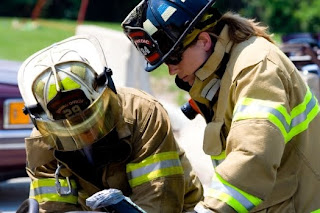



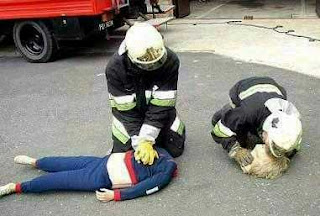


.png)



